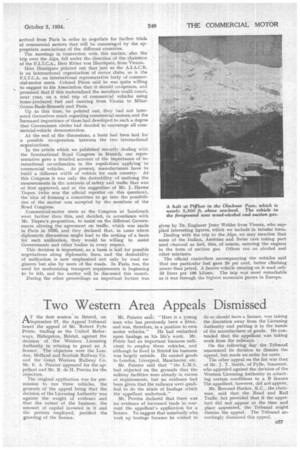Commercial Motor Users of Europe Confer
Page 54

Page 55

If you've noticed an error in this article please click here to report it so we can fix it.
Discussions Concerning the Control of European Trials of Commercial Vehicles and Vehicle Dimensions.
An Alpine Trial
THE. commercial-motor users of England, France, Germany, Belgium, Holland, Switzerland, Austria, Spain, Hungary, Italy, Czechoslovakia and Jugo-Slavia, have their representative associations which are linked together by what is commonly known as the F.I.T.C.A. Representatives of these associations met at Innsbruck, Austria, a few days ago, in order to discuss international questions affecting motor vehicles, one of the most important being the finding of a baSis of cooperation between the F.I.T.C.A. and the A.I.A.C.R., the latter being an international organization which supervises all motor races for the automobile associations.
. The other leading problem was the unification of measurements for commercial vehicles, whilst general interest IN as promoted by a trip through the Alps of Austria, Italy and .Switzerland, utilizing vehicles running on alternative fuels with a view to proving that motor spirit is not essential to carry a vehicle through the highest mountain passes ot Europe. The central countries of Europe are particularly desirous of running their motor vehicles on • fuel obtained from home products, and the Governments of Austria, Switzerland, and, particularly, Italy, are encouraging this effort.
In order to run such trials, the approval of the international racing organization of automobile clubs is necessary, but the F.I.T.G.A. took the standpoint that this approval is required only in cases where the trials are of a sporting nature, and not where they are held for practical purposes; consequently, it drew up rules of its own.
The A.I.A.C.R. was of the opinion that not only races ran for sport, but also those organized for technical purposes, should come under its control, and a conflict arose which resulted in Switzerland at first refusing to allow any commercial vehicle to pass through any part of its country on the trip over the Alps. A compromise was arrived at regarding this first trip, but Colonel Peron, of the A.I.A.C.R., and Colonel de Girardville, chairman of the technical commission of the French Automobile Club, arrived from Paris in order to negotiate for further trials of commercial motors that will be encouraged by the appropriate associations of the different countries. The meetings in connection with this matter, also the trip over the Alps, fall under the direction of the chairman of the F.I.T.C.A., Herr Ritter von Henriquez, from Vienna.
Herr Henriquez pointed out that just as the A.I.A.C.R. is an international organization of motor clubs, so is the F.I.T.C.A. an international representative body of commercial-motor users. Colonel Peron said he was quite willing to suggest to his Association that it should co-operate, and promised that if this materialized the members could count, next year, on a trial trip of commercial vehicles using home-produced fuel and running from Vienna to MilanGenoa-Basle-Brussels and Paris.
Up to this time, he pointed out, they had not interested themselves much regarding commercial motors, and the increased importance of these had developed to such a degree that Government circles had decided to encourage all commercial-vehicle demonstration.
At the end of the discussions, a basis had been laid for a possible co-operation between the two international organizations.
In the article which we published recently dealing with the International Road Congress in Munich, our representative gave a detailed account of the importance of international co-ordination in the regulations applying to commercial vehicles. At present, manufacturers have to build a different width of vehicle for each country. At this Congress it was only the desirability of unifying the measurements in the interests of safety and traffic that was at first approved, and at the suggestion of Mr. J. Harms Tiepen (who was the -official reporter on this question), the idea of forming a committee to go into the possibilities of the matter was accepted by the members of the Road Congress.
Commercial-motor users at the Congress at Innsbruck went further than this, and decided, in accordance with Mr. Tiepen's proposition, to insist on the different Governments altering the agreement on traffic, which was made in Paris in 1926, and they declared that, in cases where diplomatic discussions might lead to the seeking of a basis for such unification, they would be willing to assist Governments and other bodies in every respect.
This decision is important, as a basis is laid for possible negotiations along diplomatic lines, and the desirability of unification is now emphasized not only by road engineers but also by users of the roads. In Paris, too, the need for modernizing transport requirements is beginning to be felt, and the matter will be discussed this month.
During the other proceedings an important lecture was given by Dr. Engineer jessy Welder from Vienna, who supplied interesting figures, which we include in tabular form.
Dealing with the trip to the Alps, we may mention that some of the Italian, Austrian and Swiss cars taking part used charcoal as fuel, this, of course, entering the engines in the form of suction gas. Others ran on alcohol and other mixtures.
, The official controllers accompanying the vehicles said that one particular fuel gave 20 per cent, better climbing power than petrol. A Saurer vehicle running on it used only 33 litres per 100 kilOms. The trip was most remarkable as it was through the highest mountain passes in Europe.




































































































